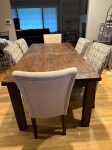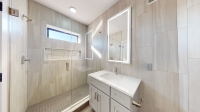COVID-19 - What will the new normal be?
joan_crystal said:
The new normal:
On-line shopping services will replace brick and mortar shopping for most. Current store fronts will become pick-up sites. Delivery slots will be auctioned off and passed down in families.
That deserves more than just a "like."
Great interview about reasonable steps to help schools open. Guest is out of Harvard, studies "healthy buildings," describes himself as a specialist in common sense. Apparently he has a publication out about (relatively) easy steps to improve ventilation etc. He promises it's only 60? pages and easy to read.... Some good news here, practical direction at last? Hope districts are paying attention.
https://www.wbur.org/onpoint/2020/07/27/back-to-school-safely
The hour also includes commentary from the superintendent of Ithaca NY schools, also very practical minded: gotta be flexible, things are likely to change month to month (if not week by week).
mjc said:
Great interview about reasonable steps to help schools open. Guest is out of Harvard, studies "healthy buildings," describes himself as a specialist in common sense. Apparently he has a publication out about (relatively) easy steps to improve ventilation etc. He promises it's only 60? pages and easy to read.... Some good news here, practical direction at last? Hope districts are paying attention.
https://www.wbur.org/onpoint/2020/07/27/back-to-school-safely
The hour also includes commentary from the superintendent of Ithaca NY schools, also very practical minded: gotta be flexible, things are likely to change month to month (if not week by week).
Israel opened their schools. Followed by school closures because of virus spread.
Can we guarantee that rambunctious kids keep their masks on all the time? One unmasked virus laden kid coughing or sneezing can give to another. The only way I see ventilation helping in a room with kids is if there are registers at their feet pushing the ventilation at a high speed straight into ceiling return ducts. Medical professionals try to limit air movement from others by wearing N95 masks and face shields but even then there are failures.
Easy common sense steps are not an answer. If they were nursing homes and hospitals would not be begging for PPE equipment while doctors and nurses are dying.
Floyd said:
mjc said:
Great interview about reasonable steps to help schools open. Guest is out of Harvard, studies "healthy buildings," describes himself as a specialist in common sense. Apparently he has a publication out about (relatively) easy steps to improve ventilation etc. He promises it's only 60? pages and easy to read.... Some good news here, practical direction at last? Hope districts are paying attention.
https://www.wbur.org/onpoint/2020/07/27/back-to-school-safely
The hour also includes commentary from the superintendent of Ithaca NY schools, also very practical minded: gotta be flexible, things are likely to change month to month (if not week by week).
Israel opened their schools. Followed by school closures because of virus spread.
Can we guarantee that rambunctious kids keep their masks on all the time? One unmasked virus laden kid coughing or sneezing can give to another. The only way I see ventilation helping in a room with kids is if there are registers at their feet pushing the ventilation at a high speed straight into ceiling return ducts. Medical professionals try to limit air movement from others by wearing N95 masks and face shields but even then there are failures.
Easy common sense steps are not an answer. If they were nursing homes and hospitals would not be begging for PPE equipment while doctors and nurses are dying.
Floyd said:
Easy common sense steps are not an answer. If they were nursing homes and hospitals would not be begging for PPE equipment while doctors and nurses are dying.
Easy common-sense steps are not always in sync with profit motives, so it may be worth keeping in mind that 70 percent of the nation’s nursing homes are run for profit, with private equity acquiring a bigger share over the last decade.
Improved ventilation, along with mask use, lots of washing, smallish pods/bubbles of kids to contain any spread, use of auxiliary spaces (auditoriums, gyms, library meeting rooms, even convention centers or other meeting places), staffed by aides if need be, to facilitate distancing, could reduce/contain contagion. They're not talking about free or even super-cheap, just doable.
The alternative, based on newspaper reporting here in Wis, is that teachers in the Milwaukee Public Schools report that they had NO CONTACT at all with 20% to 30% of their students after schools closed last spring, even though teachers were active in distributing food, supplies, etc. and reaching out to the students. Presumably it's similar in other districts - big urban districts, small less-wealthy rural districts, etc. There are just too many kids who lack connectivity/equipment/supervision/whatever to have any school experience if it's all to be "distance learning." Here, the libraries have amped up their wifi so it's available in their parking lots, but that doesn't work for kids with... no car... no adult available to drive or supervise... no wifi. And it sure won't work over the winter.
So, what's the choice: try what can be done to make schools safeR, giving parents the option of holding their kids out, or move urgently and with major funding to make sure all kids are equipped and available for distance learning (doesn't sound likely), or just leave hundreds of thousands, if not millions, of kids "in the wind," for how long?
joan_crystal said:
Smart devices will become a necessity. Credit cards will be replaced by remote payment apps.
Almost all newly issued credit cards are remote payment. All my cards are. If yours isn't then request one. I just have to hold it near the terminal. Its more convenient than an app because I don't have to get into an app. I select the credit card I want to use and hold it near the terminal.
The problem is some merchants have not upgraded to contactless payment terminals.. You still need to insert using the chip. Even when terminal accepts contactless others there may still be some physical contact required such as pushing the a approving the payment button or entering a signature. Terminals at Wegman's, Trader Joe, Aldo or Whole Foods are completely hands free. No signature, no button push. You see the total and then just hold you card near the screen. But then there is the receipt.
This pandemic has been a tough row to hoe for a lot of retail establishments. For many, as much as they might like the upgrade to contactless checkout, investing in new credit card machines may not be a viable economic option right now.
Floyd said:
mjc said:
Great interview about reasonable steps to help schools open. Guest is out of Harvard, studies "healthy buildings," describes himself as a specialist in common sense. Apparently he has a publication out about (relatively) easy steps to improve ventilation etc. He promises it's only 60? pages and easy to read.... Some good news here, practical direction at last? Hope districts are paying attention.
https://www.wbur.org/onpoint/2020/07/27/back-to-school-safely
The hour also includes commentary from the superintendent of Ithaca NY schools, also very practical minded: gotta be flexible, things are likely to change month to month (if not week by week).
Israel opened their schools. Followed by school closures because of virus spread.
Can we guarantee that rambunctious kids keep their masks on all the time? One unmasked virus laden kid coughing or sneezing can give to another. The only way I see ventilation helping in a room with kids is if there are registers at their feet pushing the ventilation at a high speed straight into ceiling return ducts. Medical professionals try to limit air movement from others by wearing N95 masks and face shields but even then there are failures.
Easy common sense steps are not an answer. If they were nursing homes and hospitals would not be begging for PPE equipment while doctors and nurses are dying.
Of course kids will not keep their masks on all of the time. More importantly the DOE is not requiring that kids wear masks all day. They are only strongly encouraging that they be worn when social distancing cannot be maintained. Not sure what SOMA will require but my district will only require them to be worn when social disatancing cannot be maintained. So, MLB teams cannot seem to play ball outside without spread, but schools will open and we will all be inside together for hours upon hours all week. How do people think this will trun out?
As to the original question . . . it depends on the results of the November election. If the current WH occupant "wins," there will be a lot more to the new normal than just masks and no handshakes. This virus will be but one small piece of the changes in the USA as we shift to an authoritarian, non-rule-of-law country. The virus situation will get a lot worse because nothing whatsoever will be done on a national level (kind of like now). When/if there's an effective vaccine, do you think it will be available to everyone? Of course not. It will either cost $1,000 per dose, or it will be in short supply so that only the oligarchs can get it.
If there's a change at the WH and/or Senate, I predict that virus-wise we will be pretty much back to normal by early 2022.
It's hard to predict. Without a national plan to fight the virus, we could be in a real helluva mess by the end of the year. If Biden wins, he'll have some hard decisions to make about locking us down for a few months to get it under control, but he might not have any other choice.
If Trump wins, God only knows what it will be like. I shudder to think about it.
shoshannah said:
As to the original question . . . it depends on the results of the November election. If the current WH occupant "wins," there will be a lot more to the new normal than just masks and no handshakes. This virus will be but one small piece of the changes in the USA as we shift to an authoritarian, non-rule-of-law country. The virus situation will get a lot worse because nothing whatsoever will be done on a national level (kind of like now). When/if there's an effective vaccine, do you think it will be available to everyone? Of course not. It will either cost $1,000 per dose, or it will be in short supply so that only the oligarchs can get it.
If there's a change at the WH and/or Senate, I predict that virus-wise we will be pretty much back to normal by early 2022.
If Trump wins, I think people have to really start thinking about whether to leave (if the border ever reopens). I know this was a a big part of our decision to leave although we didn't plan on being cutoff entirely by the border closure.
Klinker said:
shoshannah said:
As to the original question . . . it depends on the results of the November election. If the current WH occupant "wins," there will be a lot more to the new normal than just masks and no handshakes. This virus will be but one small piece of the changes in the USA as we shift to an authoritarian, non-rule-of-law country. The virus situation will get a lot worse because nothing whatsoever will be done on a national level (kind of like now). When/if there's an effective vaccine, do you think it will be available to everyone? Of course not. It will either cost $1,000 per dose, or it will be in short supply so that only the oligarchs can get it.
If there's a change at the WH and/or Senate, I predict that virus-wise we will be pretty much back to normal by early 2022.
If Trump wins, I think people have to really start thinking about whether to leave (if the border ever reopens). I know this was a a big part of our decision to leave although we didn't plan on being cutoff entirely by the border closure.
Where did you go?
temperature taking with these knock off infrared devices is worthless....they are highly inaccurate.....i have a chronic condition where i regularly get fevers....and it will still only say 98....without a fever it reads about 97.
jmitw said:
temperature taking with these knock off infrared devices is worthless....they are highly inaccurate.....i have a chronic condition where i regularly get fevers....and it will still only say 98....without a fever it reads about 97.
Someone used one of those on Wifeski the other day, while she was in the car with the AC on, it read 86.
What's the point of taking one's temp anyway? What do they do if it shows a fever?
drummerboy said:
What's the point of taking one's temp anyway? What do they do if it shows a fever?
It depends on the scenario. You might be denied entrance to the building you were seeking entry into. For instance if you had business in a hospital. Hopefully the thermometers they are using are better.
It's a good basic precaution, although the inaccuracy problem is troubling.
Temperature thing is overrated. To me it seems more like a feel good. The most highly infection stage is when they are still asymptomatic.
As for the new normal, it could have been:
Over the past six weeks, I’ve eaten out at restaurants five times, attended two concerts, visited a large, busy indoor mall three times, had two haircuts, and repeatedly watched school kids run around the schoolyard. But that’s all been responsible behavior — because instead of being locked down in my house in the D.C. area, I’ve been in France, where life and the economy are now carrying on close to normal.
https://www.washingtonpost.com/opinions/2020/07/30/us-could-learn-frances-response-covid-19/
We inflict our own pain.
Temperature monitoring is one piece of the fight. If you stop someone from a 101 fever from entering a public building you've still reduced the risk.
I think a lot of people lose sight of this. There are many things we should be doing, none of which do much individually, but in the aggregate they could get us to where France is. A quick temperature check might catch a small number of actively sick people, even if some of the thermometers aren't perfect. There's no harm, since that person was going to walk into the building anyway.
NJ sucked it up, flattened the curve and reduced new infections. If the rest of the country had been as disciplined where would we be?
So maybe stop nitpicking at some of the things that people are doing to try abd contain the spread. Unless it's something dangerous like hydroxychloroquine.
Floyd said:
The most highly infection stage is when they are still asymptomatic.
I questioned whether that assertion is really so definitive and found this CNET article, published this morning, informative.
https://www.cnet.com/health/can-asymptomatic-people-spread-covid-19/
It links to a study that “suggested that the virus is most contagious before or at the onset of symptoms.” Given the results, which were from early March, “suggested” is the operative word.
shoshannah said:
Where did you go?
British Columbia. My wife got a great job in Victoria. Initially, we were going to do a back and forth sort of thing for a while but we all ended up on the wrong (right?) side of the border when it closed so we are camping out with family in Sooke, selling our house in NJ and, eventually, buying a new one here.
It was actually kind of a hard decision to make but 6 months in, the province only has 6 patients hospitalized with Covid, the government isn't insane and I go running at French Beach three times a week.
I'm not usually in AC...room temp is normally in the 80s...yet those knock off thermometers read low....so they don't work even when not being blasted by AC
New Jersey flattened the curve, but we‘re going to be hit with a second wave. Daily numbers are already starting to go up, by September it’ll be a sh!t show again
Klinker said:
shoshannah said:
Where did you go?
British Columbia. My wife got a great job in Victoria. Initially, we were going to do a back and forth sort of thing for a while but we all ended up on the wrong (right?) side of the border when it closed so we are camping out with family in Sooke, selling our house in NJ and, eventually, buying a new one here.
It was actually kind of a hard decision to make but 6 months in, the province only has 6 patients hospitalized with Covid, the government isn't insane and I go running at French Beach three times a week.
Lucky. I am very jealous.
its not a 2nd wave until the 1st wave is gone...1st wave is still here.
jmitw said:
its not a 2nd wave until the 1st wave is gone...1st wave is still here.
Nationwide, sure. But in NJ we went to an average of 3,000 and 4,000 new cases a day to over 30 days with less than 500 cases per day. Many of those days were in the 200’s and 300’s. And this extended well over 30 days. Expecting zero cases to say the first wave is over is unrealistic.
spontaneous said:
jmitw said:
its not a 2nd wave until the 1st wave is gone...1st wave is still here.
Nationwide, sure. But in NJ we went to an average of 3,000 and 4,000 new cases a day to over 30 days with less than 500 cases per day. Many of those days were in the 200’s and 300’s. And this extended well over 30 days. Expecting zero cases to say the first wave is over is unrealistic.
The U.S. is really a collection of outbreaks on a state, county, or local level. Some places are in the middle of the first wave (FL) , some at the end of the first wave (NJ).
For Sale
Garage Sales
-
Multi Family Garage Sale Sale Date: Apr 20, 2024
More info
Free Items
Rentals
-
Huge Brand New construction Apartment in 2 family home with 4 bedrooms 3 bathrooms
4 Bd | 3Full Ba
$4,500


























The new normal:
The most vulnerable will have died from the plague. With no more hosts, the virus will dissipate. An effective vaccine will be developed before it reappears. Social security will be saved because there will be far fewer recipients to receive payments.
Smart devices will become a necessity. Credit cards will be replaced by remote payment apps. All banking and bill paying will be done on-line.
There will be fewer cars on the road as many jobs, and most educational programming and entertainment will become home based. Most events will move from live performances to on-line and TV broadcasts. Sporting events will be re-invented as virtual teams combat each other. Computer programmers skilled at creating these teams and overseeing their play will be in great demand. Home schooling will become more prevalent and will largely move on-line.
On-line shopping services will replace brick and mortar shopping for most. Current store fronts will become pick-up sites. Delivery slots will be auctioned off and passed down in families.